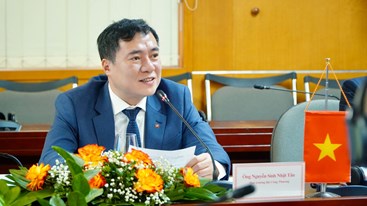Wednesday, 08/05/2024 | 01:16 GMT+7
On November 19th, the Ministry of Industry and Trade, with the assistance of German Government through the Organization of German Technical Cooperation (GTZ) and the German Energy Agency, put into use the grid connected solar system on the rooftop of the headquarters .
The system will save approximately VND 12 million per year for electricity. Using electricity from renewable energy sources is considered the radical solution for the increasing energy demand in Vietnam.
Still in the form of potential
Mr. Le Tuan Phong - Deputy Director of the Department of Energy (Ministry of Industry and Trade) – asserted that: Vietnam has great potential for almost all sources of renewable energy to produce clean energy which saves resources and does not pollute the environment.
However, up to now, energy sources still stay in the form of potential, because there have been no reasonable policies and mechanisms for electricity price to attract investors. The cheapest renewable energy sources are small hydro and hydro power, if the implementation of planning and operation are well planned and closely monitored, it will be an abundant and economic source of energy. Small hydropower is planned to have the capacity of 4.000MW, but the total installed capacity is just approximately 500MW.

The total wind power potential of Vietnam is estimated to be
about 513,360MW - 200 times as much as the capacity of the Son La hydropower plant
(in the photo: wind power column in the large Spratly island)
After hydropower is biomas sources (bagasse, rice husk - agricultural residues), there has been 150MW of electricity produced from bagasse, providing heat for sugar production. The next is wind power. According to statistics of the World Bank, the total of wind power potential of Vietnam is estimated to be about 513,360MW - 200 times as much as the capacity of Son La Hydropower plant (240MW) and 10 times as much as the total national electricity capacity planned for 2020.
Wind power is the third cheapest source of energy - after biomas and small hydropower, but the price for generating wind power is calculated to be 10 UScent/kWh, while EVN's electricity price is about 5.3 to 5.4 UScent/kWh. Binh Thuan, Ninh Thuan and Binh Dinh are provinces which attract investors in wind power sector, with the total capacity of registered plants of up to approximately 3.000MW.
However, due to the high price, investors are still awaiting to get the "green light" from the Government... Another potential energy source is solar energy. In Vietnam, solar cells are used to meet the demand for electricity of households in rural areas, mountainous and remote areas and islands - where the national grid can not reach. However, this application is very limited because the cost of solar power in still very high.
Shall the State subsidize or shall people pay?
Renewable energy is targeted to reach about 5% of the primary output by 2020 and 11% by 2050. However, to complete this goal, according to economic experts, the State must play an important role in planning mechanisms and policies, especially the price mechanism. Mr Nguyen Duc Cuong, Director of the Center for Renewable Energy and Clean Development Mechanism, said: “Currently, the average price of electricity that EVN applies to domestic users is about 5.3 to 5.4 cents per kWh”.
Meanwhile, the average price of renewable energy like wind power is 10 cents per kWh, so who will pay for the difference between selling price and buying price? Besides, the price of electricity in Vietnam is defined by the State, which is still low and not closed to the market price. Therefore, the difference between the domestic price of electricity and investment cost of renewable energy is still high. The question is “Shall the government deduct the budget to subsidize or shall the users pay for the difference?”. Mr Cuong also stressed that the state budget is not abundant so the solution to extract the budget to pay for this increase is not feasible.
Mr. Le Tuan Phong - Deputy Director of the Department of Energy (Ministry of Industry and Trade) – said: the Ministry of Industry and Trade is advising the Government in setting up a plan to develop renewable energy towards supporting investors in developing renewable energy projects to bridge the cost gap, and issuing mechanisms such as reducing raw material costs, lowering interest rates of loans from bank, encouraging owners to invest in domestic equipment, rather than import from foreign contries to reduce costs. The Ministry of Industry and Trade is also considering which type of renewable energy should be prioritized for development to be suitable for the socio-economic development and income, as well as paying capacity of people.
By Minh Duc



.png?w=367&h=206&mode=crop)




.jpg?w=367&h=206&mode=crop) Energy efficiency and conservation usage is an important aspect of the national energy development strategy
05/03/2024
Energy efficiency and conservation usage is an important aspect of the national energy development strategy
05/03/2024
 Challenges and Opportunities to promote energy efficiency market in Vietnam
Challenges and Opportunities to promote energy efficiency market in Vietnam
 The Ministry of Industry and Trade requests government agencies to coordinate in organizing Earth Hour 2024
The Ministry of Industry and Trade requests government agencies to coordinate in organizing Earth Hour 2024
 Consultation on Energy Efficiency Boiler Catalogue and Wood Drying Guideline
Consultation on Energy Efficiency Boiler Catalogue and Wood Drying Guideline
.png?w=367&h=206&mode=crop) Request for expression of interest - C2.1.13: Capacity Building on energy efficiency policies development
Request for expression of interest - C2.1.13: Capacity Building on energy efficiency policies development
 Son Ha Co., Ltd, applies energy efficiency and conservation measures
Son Ha Co., Ltd, applies energy efficiency and conservation measures
 Phuc Kien Co., Ltd., is effectively implementing energy-saving measures
Phuc Kien Co., Ltd., is effectively implementing energy-saving measures
 Request for expression of interest - C2.1.12: Independent monitoring of safeguards implementation
Request for expression of interest - C2.1.12: Independent monitoring of safeguards implementation